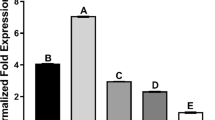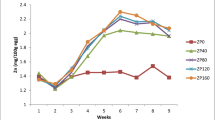Abstract
An experiment was conducted to investigate the effects of zinc glycinate (Zn-Gly) supplementation as an alternative for zinc sulphate (ZnSO4) on productive and reproductive performance, zinc (Zn) concentration and antioxidant status in broiler breeders. Six hundred 39-week-old Lingnan Yellow broiler breeders were randomly assigned to 6 groups consisting of 4 replicates with 25 birds each. Breeders were fed a basal diet (control group, 24 mg Zn/kg diet), basal diet supplemented with 80 mg Zn/kg diet from ZnSO4 or basal diet supplemented with 20, 40, 60 and 80 mg Zn/kg diet from Zn-Gly. The experiment lasted for 8 weeks after a 4-week pre-test with the basal diet, respectively. Results showed that Zn supplementation, regardless of sources, improved (P < 0.05) the feed conversion ratio (kilogram of feed/kilogram of egg) and decreased broken egg rate, and elevated (P < 0.05) the qualified chick rate. Compared with the ZnSO4 group, the 80 mg Zn/kg Zn-Gly group significantly increased (P < 0.05) average egg weight, fertility, hatchability and qualified chick rate, whereas it decreased (P < 0.05) broken egg rate. The Zn concentrations in liver and muscle were significantly higher (P < 0.05) in 80 mg Zn/kg Zn-Gly group than that in ZnSO4 group. Compared with ZnSO4 group, 80 mg Zn/kg Zn-Gly group significantly elevated (P < 0.05) the mRNA abundances of metallothionein (MT) and copper-zinc superoxide (Cu-Zn SOD), as well as the Cu-Zn SOD activity and MT concentration in liver. Moreover, the 80 mg Zn/kg Zn-Gly group had higher (P < 0.05) serum T-SOD and Cu-Zn SOD activities than that in the ZnSO4 group. This study indicated that supplementation of Zn in basal diet improved productive and reproductive performance, Zn concentration and antioxidant status in broiler breeders, and the 80 mg Zn/kg from Zn-Gly was the optimum choice for broiler breeders compared with other levels of Zn from Zn-Gly and 80 mg/kg Zn from ZnSO4.


Similar content being viewed by others
References
Prasad AS, Kucuk O (2002) Zinc in cancer prevention. Nutr Cancer 21:291–295
Bun SD, Guo YM, Guo FC et al (2011) Influence of organic zinc supplementation on the antioxidant status and immune responses of broilers challenged with Eimeria tenella. Poult Sci 90:1220–1226
Virden WS, Yeatman JB, Barber SJ et al (2004) Immune system and cardiac functions of progeny chicks from dams fed diets differing in zinc and manganese level and source. Poult Sci 83:344–351
Gao J, Lv Z, Li C et al (2014) Maternal zinc supplementation enhanced skeletal muscle development through increasing protein synthesis and inhibiting protein degradation of their offspring. Biol Trace Elem Res 162:309–316
Hudson BP, Dozier WA, Fairchild BD (2004) Live performance and immune responses of straight-run broilers: influences of zinc source in broiler breeder hen and progeny diets and ambient temperature during the broiler production period. J Appl Poult Res 13:291–301
Sun Q, Guo Y, Ma S et al (2012) Dietary mineral sources altered lipid and antioxidant profiles in broiler breeders and post hatch growth of their offsprings. Biol Trace Elem Res 145:318–324
Oestreicher P, Cousins RJ (1985) Copper and zinc absorption in the rat: mechanism of mutual antagonism. J Nutr 115:159–166
Leeson S (2003) A new look at trace mineral nutrition of poultry: can we reduce environmental burden of poultry manure. In: Lyons TP, Jacques KA (eds) Nutritional biotechnology in the feed and food industries. Nottingham Univ. Press, Nottingham, pp 125–131
Star L, Van der Klis JD, Rapp C et al (2012) Bioavailability of organic and inorganic zinc sources in male broilers. Poult Sci 91:3115–3120
Huang YL, Lu L, Xie JJ et al (2013) Relative bioavailabilities of organic zinc sources with different chelation strengths for broilers fed diets with low or high phytate content. Anim Feed Sci Technol 179:144–148
Sridhar K, Nagalakshmi D, Rama Rao SV (2015) Effect of graded concentration of organic zinc (zinc glycinate) on skin quality, hematological and serum biochemical constituents in broiler chicken. Indian J Anim Sci 85:643–648
Suo H, Lu L, Zhang L et al (2015) Relative bioavailability of zinc-methionine chelate for broilers fed a conventional corn–soybean meal diet. Biol Trace Elem Res 165:206–213
Ma W, Niu H, Feng J et al (2011) Effects of zinc glycinate on oxidative stress, contents of trace elements, and intestinal morphology in broilers. Biol Trace Elem Res 142:546–556
dos Santos TT, Corzo A, Kidd MT et al (2010) Influence of in ovo inoculation with various nutrients and egg size on broiler performance. J Appl Poult Res 19:1–12
Feng J, Ma WQ, Niu HH et al (2010) Effects of zinc glycinate on growth, hematological, and immunological characteristics in broilers. Biol Trace Elem Res 133:203–211
Livak KJ, Schmittgen TD (2001) Analysis of relative gene expression data using real-time quantitative PCR and the 2−ΔΔct method. Methods 25:402–408
China Feed Database (1999) Table of feed composition and nutritive value in China: 1998 edition. China Feed 4:25–31
Amen MHM, Al-Daraji HJ (2012) Effect of dietary zinc on productive performance of broiler breeder chickens. Int J Appl Poultry Res 1:5–9
Torki M, Akbari M, Kaviani K (2015) Single and combined effects of zinc and cinnamon essential oil in diet on productive performance, egg quality traits, and blood parameters of laying hens reared under cold stress condition. Int J Biometeorol 59:1169–1177
Hudson BP, Dozier WA, Wilson JL et al (2004) Reproductive performance and immune status of caged broiler breeder hens provided diets supplemented with either inorganic or organic sources of zinc from hatching to 65wk of age. J Appl Poult Res 13:349–359
Amen MHM, Al-Daraji HJ (2011) Influence of dietary supplementation with zinc on sex hormones concentrations of broiler breeder chickens. J Nutr 10:1089–1093
Amen MHM, Al-Daraji HJ (2011) Effect of dietary supplementation with different level of zinc on sperm egg penetration and fertility traits of broiler breeder chicken. Pak J Nutr 10:1083–1088
Soni N, Mishra SK, Swain RK et al (2014) Effect of supplementation of organic zinc on the performance of broiler breeders. Anim Nutr Feed Technol 14:359–369
Yair R, Uni Z (2011) Content and uptake of minerals in the yolk of broiler embryos during incubation and effect of nutrient enrichment. Poult Sci 90:1523–1531
Kucuk O (2008) Zinc in a combination with magnesium helps reducing negative effects of heat stress in quails. Biol Trace Elem Res 123:144–153
Oteiza PL, Olin KL, Fraga CG et al (1996) Oxidant defense systems in testes from Zn deficient rats. Proc Soc Exp Biol Med 213:85–91
Zhao CY, Tan SX, Xiao XY et al (2014) Effects of dietary zinc oxide nanoparticles on growth performance and anti-oxidative status in broilers. Biol Trace Elem Res 160:361–367
Liu ZH, Lu L, Wang RL et al (2015) Effects of supplemental zinc source and level on antioxidant ability and fat metabolism-related enzymes of broilers. Poult Sci 94:2686–2694
Cao J, Henry PR, Davis SR et al (2002) Relative bioavailability of organic zinc sources based on tissue zinc and metallothionein in chicks fed conventional dietary zinc concentrations. Anim Feed Sci Technol 101:161–170
Shen SF, Wang RL, Lu L et al (2013) Effect of intravenously injected zinc on tissue zinc and metallothionein gene expression of broilers. Br Poult Sci 54:381–390
Sahin K, Smith MO, Onderci M et al (2005) Supplementation of zinc from organic or inorganic source improves performance and antioxidant status of heat-distressed quail. Poult Sci 84:8
Acknowledgements
All procedures in this trial were approved by the Animal Care and Use Committee of Zhejiang University.
Author information
Authors and Affiliations
Corresponding author
Ethics declarations
Funding
This study was funded by the China Agricultural Research System (project CARS-42-G19, Beijing, China).
Conflict of Interest
The authors declare that they have no competing interests.
Rights and permissions
About this article
Cite this article
Zhang, L., Wang, YX., Xiao, X. et al. Effects of Zinc Glycinate on Productive and Reproductive Performance, Zinc Concentration and Antioxidant Status in Broiler Breeders. Biol Trace Elem Res 178, 320–326 (2017). https://doi.org/10.1007/s12011-016-0928-4
Received:
Accepted:
Published:
Issue Date:
DOI: https://doi.org/10.1007/s12011-016-0928-4




